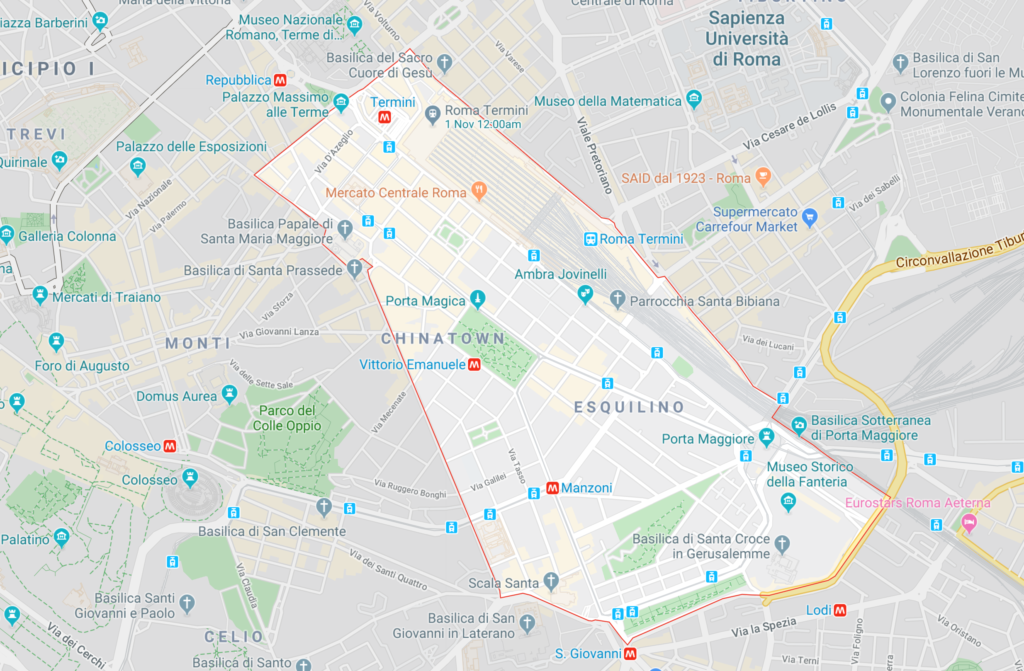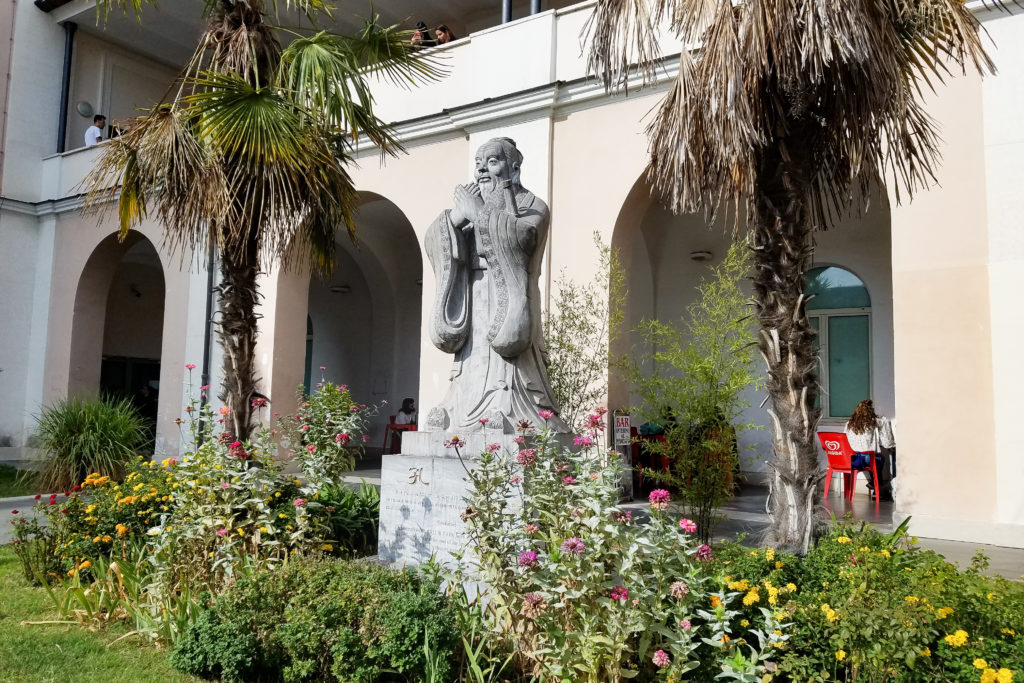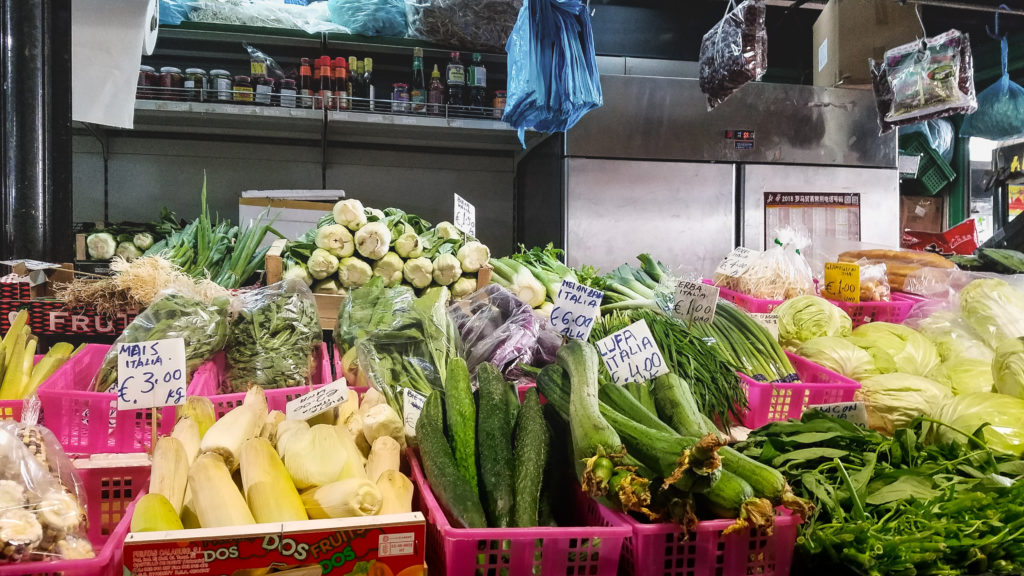I have never taken a political science class before, so I didn’t know what to expect when I enrolled in Immigration, Race, and Identity in Contemporary Italy. The topics and discussions in the class really challenge me to consider perspectives and ask questions I wouldn’t have thought about otherwise.
I’m always excited to learn new things from Professor Rinelli and from my peers in the classroom. For the session before our midterm exam, however, I was in for a bigger treat: a field trip to Piazza Vittorio in the middle of the city!
One of the readings we did for the class focused on the experiences of people who migrated to Rome, both from within and outside of Italy. We read a book titled Clash of Civilizations Over an Elevator in Piazza Vittorio. The book is a murder-mystery organized into testimonies from different characters, with each one coming from a different place and having a different story to tell. We examined the characters’ histories and prejudices and analyzed them in the context of broader questions such as why people migrate (and what separates different types of migrants – immigrants, refugees, and asylum-seekers – from each other), what stereotypes develop about certain groups, and what kinds of challenges do migrants face in Rome today.

Our guide worked for Migrantour, a non-government organization (NGO) that strives to raise awareness about the cultural diversity of Europe by organizing tours of multicultural cities. She introduced herself as an Albanian immigrant who lived in Rome for 16 years. I was excited to learn from a migrant in Rome, especially when discussing migration and diversity!
The tour focused on the Esquilino Square, which is the most culturally-diverse area in the center of Rome. Unlike the districts filled with the remnants of ancient times, the was developed as a way to modernize the city after Rome became the capital of Italy in 1871. Italy was not a unified country since the end of the Roman empire until the mid-19th century, when Vittorio Emanuele II, the king of Sardinia, became king of all of Italy. The area called Piazza Vittorio Emanuele (near the Vittorio Emanuele Metro station, right after the Termini stop), called Piazza Vittorio for short, is named after him.

We left our meeting-point at the Basilica of Santa Maria degli Angeli in downtown Rome and walked a few minutes past Termini station. Roma Termini is the largest station in Rome and is the major center for buses, the Roma metro, trains, and rides to the airport. I’ve been there multiple times to transfer to the Metro B or to catch trains to places outside of Rome, but I have never learned about the history in much detail until our class trip that mid-October morning.

We stopped at a place near the station, which Professor Rinelli described as a crucial location for migrants, since it was at the center of the city and held its main point of transportation and movement. It was a center for migrants that offers several different services for people who migrated to Rome from different places. Not only is this place a school where migrants can learn Italian (similar to the place my parents and sister took ESL (English as a second language) when they first moved to the United States), it is also a place where migrants can find legal advice for their status as immigrants or asylum-seekers and obtain medical assistance, a crucial service for the survival of vulnerable people.
It appears to be run-down, but this is only because it is very difficult to run a center like this one. The organization is not funded by the government or the church – in Rome, when it comes to helping human beings, a lot of things need to go through the Vatican. Furthermore, it is especially difficult for migrant women, especially Muslim women, to integrate into Italian society. Professor Rinelli added that this is an issue of marginalization because of religion and gender.

Around the migrant center were murals by a street artist named Sgarbi. To the right of the building, painted on the corner, was a portrait of Alberto Manzi. He was a teacher who taught Italian to one million people through television in the 1960’s. To the left was a larger painting of Dante Alighieri, author of the Divine Comedy, which includes Inferno, Purgatorio, and Paradiso (the first of which is what we call “Dante’s Inferno“) and widely considered the father of Italian language and culture. That is the reason why Dante is facing an African woman: the mural is a message and commentary on the multicultural society gravitating around the center.
Sgarbi’s work around the migrant center is one of the most moving things I’ve seen in Rome. I’ve always known I was an immigrant: I noticed that my family and I looked different from most people in Boston since I was in elementary school, and when I was a little older, I learned about my family’s journey to the United States. However, it wasn’t until I started taking this class that I learned what it means to be a migrant.

From a young age, I’ve understood how important it is to learn the lingua franca of a place. I was luckier than the rest of my family because I never needed to learn English as a second language: I grew up in Boston and learned English at the same time as the other children. I do not speak with the same accent as my parents or my sister and did not have the same struggles with reading and writing as they did. I remember being around my parents when they got phone calls in English and sometimes explaining what the person on the other end of the line was saying. I remember speaking on the phone in English myself when my parents got too confused to understand what the other person was saying.
Seeing the picture of Manzi and learning about who he was and what he did for a million people really touched me. The fact that he was able to teach so many people the valuable skill of communicating with, understanding, and creating bonds with others through television is amazing. Learning about the meaning of the mural also brought me back to my childhood. My mother told me that when I was little, she and I would watch children’s programs on TV. Most of my family’s exposure to English at home came from the television back then, and I grew up watching the same shows as my classmates did. We got better at English through watching TV, and I think I learned a lot of my English from the kids’ shows that focused on vocabulary and grammar. I could relate to the people who learned Italian through watching Manzi on TV in the 60’s.
 Another one of Sgarbi’s works: Dante (who wrote Inferno) face-to-face with an African woman. A very important piece around Termini!
Another one of Sgarbi’s works: Dante (who wrote Inferno) face-to-face with an African woman. A very important piece around Termini!
Professor Rinelli mentioned that adding the image of the African woman facing Dante on a wall around Termini was also a strong statement in favor for integrating migrants in Rome. I thought about his point about how migrant women in particular struggle to integrate more than migrant men do. I felt sorry for migrant women in Rome after hearing that – I am a migrant woman myself – and found solace in seeing the woman in the mural juxtaposed with the one and only Dante. The deeper meaning of Sgarbi’s piece gave me hope that integration is happening right here and now, and made me fully realize that this progress is unfolding right in front of us thanks to the power of these artistic representations.
We concluded our time outside the migrant center learning about the general time periods of migration in this part of Rome. The first major wave of immigration from places outside of Italy happened in the 1970’s. Italy was first a nation of emigration, but we also learned that in the late 19th-century, after the unification of Italy, Piazza Vittorio has always been a melting pot of cultures and languages from the workers who built the area after they moved here with hopes for better lives. It wasn’t until decades later when more people started moving into Italy from other countries.

The first groups of immigrants were from North Africa, in particular Ethiopia, Eritrea, and Somalia, countries that Italy once colonized and were part of the Fascist Empire during World War II. There were also people moving to this block in Rome from southern Italy. This part of the city was fairly empty at the time because of an economic crisis, and the new immigrants opened small shops in the properties, which were later purchased by Chinese immigrants.
We headed further downtown toward the Mercato Esquilino. In 1991, it was an open market that was a setting for The Bicycle Thieves, one of the most famous neo-realistic Italian films that was also hit in international cinemas. The Mercato was then moved into a new closed space in 2001. It is the largest and the most important market in Rome, with roughly 150 shops, most of which are food and grocery stands.
On our way, we stopped by a garden that was once part of the department of Asian languages at the Sapienza University of Rome, a few minutes north of Esquilino. There, I was surprised to see a statue of Confucius, a Chinese philosopher, of all people! Professor Rinelli described the piece as something “unique” to Rome and in Italy overall. He said that the art in Italy is mostly euro-centric and that there are almost no references to other religions or cultures, so a piece of Asian art on display in a public space is rare to see. I’m glad I got to see it on this field trip!

We made our way to the market and entered to see a bustling area inside. There were too many shops to count, and I saw people selling things from different types of clothing, accessories, food, household essentials…you name it!
We walked through the first part of the market and headed outside to the newer part of the Nuovo Mercato Esquilino. We learned about an initiative to give unsold goods to marginalized people in the area. So far, the market has donated a lot of food. I was happy to hear that everything is going to good use, even if unsold. It feels nice to know that people are helping those less fortunate than they are in this way.


We turned around and saw another one of Sgarbi’s pieces: a mural of a woman and a child reaching toward a scene of different fish in the ocean. On the top left were the words “Diversita Elemento Di Vita,” which means “Diversity is the element of life.” A powerful message that added to his other works around Termini!


The new part of the market was even busier than the first part. I saw a lot of fresh grocery stands selling produce, meat, fish, spices, and condiments. I walked past a display of bok choy and Chinese eggplants and got hungry. These are things my family and I always buy at Asian supermarkets back home. The stand made me think of my mother and her cooking. I could almost imagine smelling fresh eggplants cooking in our wok with some soy sauce and garlic. I think I’ll call Mom and ask for her recipes so I can make use of the nostalgic vegetables I saw on this trip.
On our walk through the market, I heard some of the people greet me with not “Hello” or “Hi,” but with the standard Chinese “Ni hao!”

Professor Rinelli told me that a lot of the people working in the Nuovo Mercato Esquilino were migrants or descended from migrants, and that they know “how to treat a Chinese.” I asked him if people in Rome saw me as American or Chinese, and he said that if I don’t speak, I am Chinese. I am 100% Chinese by blood, so it makes sense. Wait until they hear me speak Italian with an American accent!
Our last part of our adventure in the market was a short talk with one of Professor Rinelli’s friends, Omar. His family has run several butcher shops in the area for 39 years. He surprised me by speaking to me in Chinese. It turns out that he is a polyglot, speaking Spanish, French, Tagalog, Romanian, Chinese, and English! We also met his father, who told us about the importance of selling halal meat in Rome. Butchers like Omar and his father provide a valuable service to the Muslim community in the city.
Islam is not the only Abrahamic religion that is part of Italian society. There is a long history of Judaism in Rome, with services that offer kosher food is important in the city. Islam’s entrance into Italian society is fairly recent compared to the centuries of Jewish history in Rome. Learning about the cultural history at the butcher stand was a unique experience. I found Omar’s father’s explanation of how to prepare halal meat fascinating – I really learned a lot from him! Right behind us was a Chinese butcher stand that also prepares halal meat. I was amazed by this additional layer of cultural diversity in the market! It makes me happy to see people from different cultures cater to each other.

We said goodbye to Omar and his father and headed outside. We said another goodbye to our Migrantour guide and met in a square for a little bit to discuss the last part of the book. After a discussion on how the author captures the experiences of migrant women, I learned more about the history of the place.
The Esquilino square is, as Professor Rinelli said, “what you might call a melting pot in the United States” with people speaking different languages. In a way, he added, it was like a Babylon. In the 1990’s, the market was spread all around the square. I can only imagine what that must have been like, a square surrounded by markets stocked with international goods! Luckily, I can visit the old Esquilino through The Bicycle Thieves, the movie Professor Rinelli mentioned earlier. I can’t wait to watch such a famous film!
Finally, we learned about the architecture in this area and how it reflects the multi-layered soul of the ancient city. The psychology major in me was excited to recall that Professor Rinelli mentioned Sigmund Freud’s Interpretation of Dreams and likened it to Rome: he wrote, “Dreams stand to childhood memories, in the same relations as some baroque places in Rome to the ancient ruins, whose slabs and columns have provided the material for the construction of modern forms.”
I found it hard not to laugh when Professor Rinelli said that the architecture around us “makes no sense in Rome.” He himself is a Roman, and many parts of Rome do not look completely Roman. There was structural influence from northern Italy and from models categorized as the “Parisian style.” There is also a lack of balconies, which I hadn’t noticed until then. Fascinating how much you notice after learning about it firsthand!
This trip captures my favorite parts of studying abroad. Not only do I get to take classes on topics I had never tried to learn before, but I can also get am immersive approach through experiencing the topics in the real city. I’ll admit that Immigration, Race, and Identity in Contemporary Italy is one of the hardest classes I’ve ever taken, but it is a very fun challenge I am eager to take on. I look forward to learning more about the world around me through further adventures in Rome.



Hello every one, here every one is sharing these familiarity,
so it’s fastidious to read this web site, and I used to pay a quick visit
this web site every day.